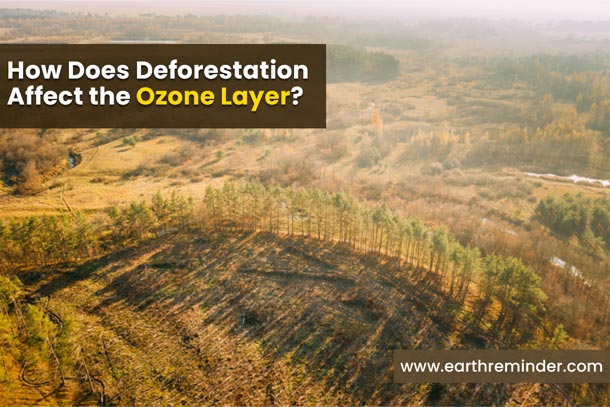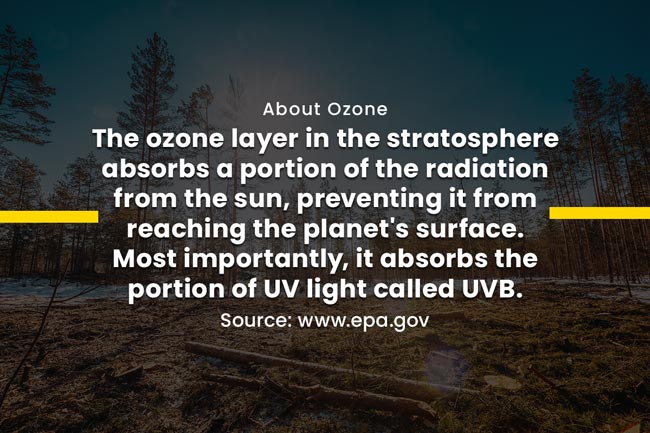How Does Deforestation Affect the Ozone Layer?
Deforestation and Ozone Depletion: How Does Deforestation Affect the Ozone Layer?
Located between 15-30 kilometers above the Earth’s surface, the ozone layer forms a protective shield around the planet. It filters out the sun’s harmful ultraviolet radiation. This helps protect human health by limiting the amount of UV-B rays that reach the Earth’s surface.
High levels of ultraviolet radiation can damage plants, species, and even materials. Therefore, the ozone layer is vital to the survival of life on the planet. Furthermore, by reducing the amount of sunlight reaching our planet, it prevents the destruction of our planet’s ecosystems.
However, this essential component of Earth’s life-supporting system is in danger, mainly due to ozone depletion. This process is caused by human activities, deforestation, global warming and is directly related to climate change. Many scientists disagree about the causes, but most agree that Deforestation affects the ozone layer.
In this article, we will explore the possible impact of deforestation on the ozone layer and whether or not Deforestation leads to the depletion of the ozone layer.
Table of Contents
Findings of Ozone Depletion & The Steps Taken to Prevent It
During the 1970s, the international panel concluded that the ozone layer was in danger of depletion just over the tropics. Satellite measurements supported the results.
The findings led to the signing of the Montreal Protocol treaty prohibiting the production, use, and transfer of certain chemical substances that Deplete the Ozone Layer in 1987.
The Protocol also allows periodic revision of phase-out schedules for ozone-depleting substances (ODS). The major halocarbon producing nations then agreed to phase out the production of CFCs, halons, and other related compounds.
Over the last three decades, humans have made progress in limiting the damage to the ozone layer, but the damage continues. Many scientists are worried that the ozone layer will eventually be destroyed despite the progress. This would be a massive problem for the planet, and it would need to be addressed immediately.
Does Deforestation Cause the Depletion of The Ozone Layer?
The ozone layer is a thin layer of ozone gas in the lower stratosphere. It prevents harmful ultraviolet rays from reaching Earth’s surface. Human made chemicals like halons, Chlorofluorocarbons (CFCs), and Hydrofluorocarbons (HCFCs) are responsible for depleting the ozone layer. However, Deforestation is also a major contributor.
While CFCs are the primary contributor to ozone depletion, Deforestation indirectly leads to low ozone levels in the upper atmosphere. Deforestation leads to a higher level of CO2 in the atmosphere, which is a greenhouse gas. It forms a blanket around the Earth that traps sunlight and heat the lower atmosphere. Increasing concentrations of heat-trapping gasses in the stratosphere make the blanket much thicker. Hence, the Earth’s surface is warming continuously. However, these heat-trapping gasses reduce the amount of heat reaching the stratosphere resulting in the cooling of the upper atmosphere. In turn, this coldness in the stratosphere causes the ozone layer to shrink. Ozone loss further accelerates the cooling effect, which in turn deplete the ozone further, forming a chain reaction.
Besides, the Ozone Layer is made purely of oxygen, with three oxygen atoms making the ozone molecules. Deforestation directly impacts the oxygen cycle leading to a lower oxygen level in the atmosphere. As the Earth’s ozone layer needs oxygen to survive, there is a possibility that a lower oxygen level due to Deforestation could lead to thinning of the ozone layer.
Scientists have been trying to understand how Deforestation affects ozone depletion. While trees alone won’t reduce ozone depletion, they have found that planting forests near major sources of air pollution can help mitigate the problem. Reforestation is cheaper and more efficient than engineering-based techniques.
The extent of Ozone Layer Depletion
As per the World Meteorological Organization (WMO), there is a large and deep ozone hole in Antarctica in the year 2020; the ozone hole was expected to continue to expand from August to early October. Antarctica’s ozone hole grew to an area of 24 million square kilometers. The size of the hole has increased in the last decade. It reached its maximum of 23 million Km2, covering most of the Antarctic continent.
In the Arctic and Antarctic, ozone has decreased by about one-third in the last three decades. According to scientists, “it appears that the ozone hole has reached its maximum” in 2020.
Special Issue on Forests: How Does Ozone Depletion Affect Forest Ecosystems and Plants?
The ozone-depletion-induced impacts on forests may affect the composition and function of the soil in the rhizosphere.
As per the study – “Ozone has a much greater effect on rhizosphere microbial processes than on those of non-rhizosphere soil due to the decreased C exudates from the roots of the O 3 -exposed crop.”
Additionally, UV rays that reach soil due to ozone depletion significantly impact the life-supporting ability of the soil. UV rays sterilize the soil, killing off the essential microbial life, like the nitrogen-fixing bacteria critical for plant growth. Moreover, it reduces the nutrient content of the soil and has damaging effects on plant and animal life. Besides that, “Ozone degrades floral scent and reduces pollinator attraction to flowers.”
The effects on the environment due to ozone depletion could be extremely drastic. Aside from the negative consequences on plants, ozone damage can cause a decline in forest productivity. It is evident that the Ozone layer is an essential component for the overall maintenance and survival of Earth’s ecosystems.
Ozone Depletion and Its Effects on Health
The ozone layer is the protective layer between the Earth and the sun. It absorbs the sun’s ultraviolet rays and thus protects humans and other organisms from harmful UV rays. But the ozone layer is destroyed when chemicals, such as chlorofluorocarbons deplete it.
As the ozone layer continues to thin, people are exposed to the harmful effects of UV-rays, which adversely affects human health. Harmful UV rays are known to cause various skin problems in humans including skin cancers.
Conclusion
Besides the CFCs and Halons, Deforestation also significantly contributes to the destruction of the ozone layer. While its effects may not be as apparent as the other direct contributors to ozone depletion, Deforestation nonetheless is a primary culprit. In the last 30 years, this protective barrier has become significantly thinner and is now under threat. But we have made significant progress.
It is possible to keep the ozone layer intact. To do so, we must check the deforestation rate, plant more trees and most importantly, reduce the number of chemicals that deplete the ozone layer. For example, we should stop using chemicals that contain chlorofluorocarbons and other ozone-depleting substances (ODS).
Only the cumulative efforts of scientists, governments, big corporations and individuals alike could save this protective layer essential for the survival of life on Earth.
Do you have more points for the add-on? Or would you like to express your views on it? Or any corrections? Comment down below. We will indeed consider it.

